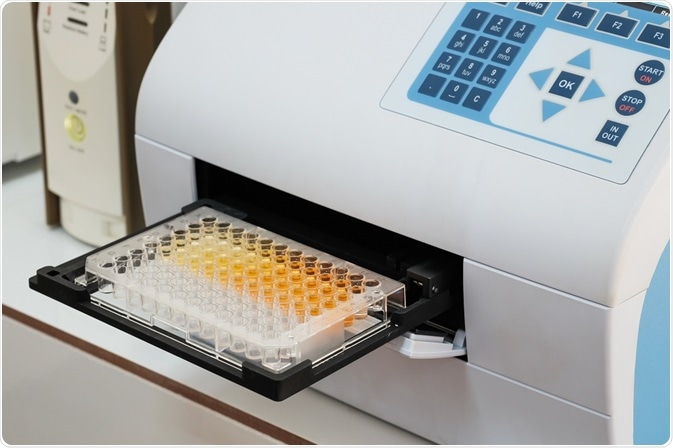Immunoassays are bioanalytical methods that use the specificity of an antigen-antibody reaction to detect and quantify target molecules in biological samples. These methods are frequently used in clinical diagnostics, drug discovery, drug monitoring, and food testing.

Khamkhlai Thanet | Shutterstock
Types of immunoassays
The principle of an immune assay is based on competitions between a fixed amount of labeled analyte and a variable amount of unlabeled sample analyte for binding a limited number of binding sites of an antibody specifically raised against the analyte. These methods can be used to detect a target molecule quantitatively, semiquantitatively, or qualitatively.
Radioimmunoassay (RIA)
Radioimmunoassays use a radioisotope as a label to quantify hormones, drugs, and viral antigens. A known concentration of radiolabeled antigen is incubated with a fixed concentration of antibody specific for that antigen. This radiolabeled antigen-antibody complex is then mixed with a biological sample containing an unknown concentration of the same antigen.
In principle, if the concentration of sample antigen is higher than the radiolabeled antigen, the sample antigen will bind the limited number of antibody binding sites by replacing the radiolabeled antigen. Next, the radioactivity of these free (not bound to an antibody) radiolabeled antigens is measured; which is directly proportional to the concentration of unlabeled antigen present in the biological sample.
However, the short half-life of radioisotopes, as well as health hazards associated with their use, considerably limits the application of this method in many laboratories.
Enzyme-linked Immunosorbent Assay (ELISA)
In an ELISA, an enzyme is linked to an antibody that has been specifically raised against an antigen of interest.
Biological samples containing the target antigen are allowed to bind the enzyme-labeled antibody and the reaction is visualized using an enzyme-specific substrate which is added to the reaction mixture. The enzyme-specific substrate binds to the enzyme attached to the antibody, generating a colored product which can be detected using chromogenic or chemiluminescent imaging techniques.
ELISA has a high specificity and sensitivity, thus it is frequently used for high-throughput screening of antibodies or drugs.
Fluoroimmunoassays
Fluorescent probes are used to label antibodies. Biological samples containing an antigen of interest is incubated with a fluorescent-labeled antibody. The fluorescence intensity of the resulted antigen-antibody complex is measured to quantify the target antigen.
Chemiluminescence immunoassays
Luminescent molecules when return from an excited state to a ground state, emit visible or near-visible light (luminescence), which can be detected by luminescent signal measuring devices.
In chemiluminescence immunoassays, luminophore markers, such as acridinium esters, can be used directly; or enzymatic markers including alkaline phosphatase and horse radish peroxidase can be used indirectly with adamantyl 1, 2-dioxetane aryl phosphate (AMPPD) and luminol substrates, respectively.
The major advantage of this method is that the readout can be increased by using enhancers, which allow the reaction to continue for a longer time without reducing the signal intensity.
Counting immunoassays
Counting immunoassays use particle counting technology. Polystyrene beads (Latex particles) are coated with antibodies specific for an antigen of interest. When incubated with a biological sample containing the target antigen, these beads form immune complexes, which form visible clumps (agglutination).
Depending on the concentration of target antigen, some beads remain unbound and can be counted using a cell counter. The number of unbound beads inversely denotes the concentration of target antigen.
Trends in immunoassays
Advanced immunoassays are being developed that are ultra-sensitive and less time consuming. The surface plasmon resonance (SPR)-based label-free immunoassay is one such example that comes with many special features, such as superfast analysis (within minutes), minimal requirement of sample and reagents, label-free microfluidic immunoassay protocol, and fully automated system with a high-throughput.
In addition, smartphone-based immunoassay formats, multiplex bead-based assays, lateral flow immunoassay formats are among the latest developments that have facilitated monitoring and management of health-related complications in real-time.